46th Quartermaster Graves Registration Company Unit History
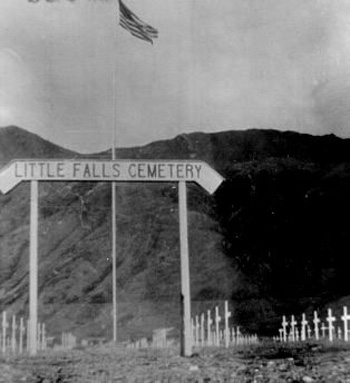
Entrance to Little Falls Cemetery on Attu, Aleutians Islands, 1943 (the cemetery was relocated to Fort Richardson, Anchorage, Alaska in December 1946).
Introduction & Activation:
The ‘basic’ mission of the US Quartermaster Corps (QMC) was to procure, store, and distribute – food, clothing, and individual and organizational equipment, as well as general supplies and all fuels and lubricants (except aviation gasoline) – used by all the US Armed Forces. Moreover, the QMC procured and trained horses, mules, and dogs, and in addition provided special services to the troops in the field. Included in their activities were the operation of field bakeries, the provision of laundry, sterilization, bathing, and related sanitary facilities, the collection and disposal of salvage, the repair and maintenance of shoes, clothing, and equipment (QMC issue), but also the care for the dead …
The Quartermaster Graves Registration Company belonged to the group of QM General Service organizations.
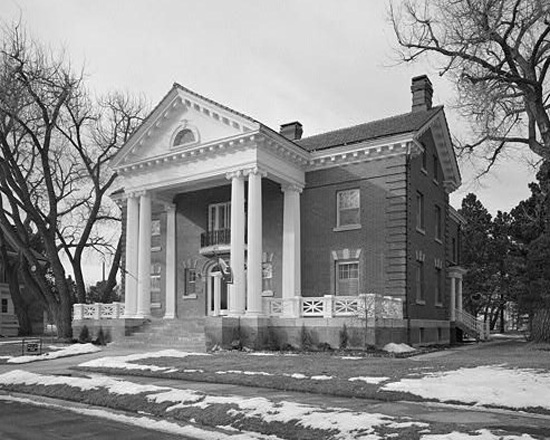
View of Commanding Officer’s Quarters, Fort Francis E. Warren, Cheyenne, Wyoming (Army Service Forces and Quartermaster Corps Training Center).
The 46th Quartermaster Graves Registration Company’s official date of activation was 28 March 1942, and the location Fort Francis E. Warren, Cheyenne, Wyoming which was a Quartermaster Unit Training Center. According to some official OQMG sources, a number of NCOs and EM of the Provisional Platoon, 46th Quartermaster Graves Registration Company, were attached to some American combat units during the Buna-Gona (New Guinea) 19 November 1942 – 2 January 1943 Campaign. (Furthermore, basic information was discovered indicating that the organization participated in the Aleutians Campaign in 1943, and that it was responsible to recover the dead and participate in establishing Little Falls Cemetery on Attu –ed).
Training:
By fall of 1940, Graves Registration Service units had originally only been planned on paper and each Army Corps had “theoretically” been assigned 1 (one) Company consisting of 4 (four) Platoons. No GRS units were ever trained during the emergency period and therefore none participated in the 1940-1941 Army Maneuvers in the ZI. Following the entry of the United States into the war, and within the WD Augmentation Mobilization Plan of 1942, a number of 13 Quartermaster Graves Registration Companies were activated between 28 March and 2 December 1942 in the Zone of Interior (although they did not receive unit training nor adequately trained cadres –ed). Facilities for unit training would only become available early in 1943.
It is assumed that in case the organization received an adequate training, same would have taken place at one of the two Quartermaster Corps Training & Replacement Centers, such as Camp Lee, Petersburg, Virginia, or Fort Francis E. Warren, Cheyenne, Wyoming. These centers, established in 1941, were placed under administrative control of the respective Corps Areas where located, but the Quartermaster General remained responsible for conducting all training activities.
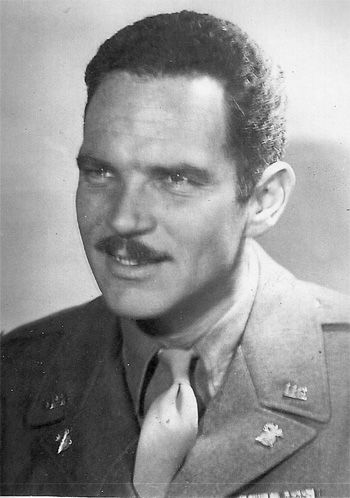
Portrait of Captain Merwin J. DeKorp, QMC, O-406311, Commanding Officer, 46th Quartermaster Graves Registration Company (photo taken in Paris, France, March 1945).
As a consequence of the lack of trained personnel, initial operations of Theater GRS personnel were generally characterized by field improvisations. The shortage of such units, the complexity of such an organization and the scope of its operations, affected the development of measures designed to promote standardization in clerical forms, operating procedures, and technical practices. The integration of elements pertaining to Graves Registration Service units into active Theaters of Operations was first tested in North Africa, Sicily, and Italy, where the Theater Commander was responsible for the security, care, and maintenance of military cemeteries.
Standard Operation Procedures – Burials:
In World War Two, burials of the dead in a Theater of Operations (i.e. overseas) were generally divided into different classes, depending upon the urgency for immediate interment, the presence or absence of Graves Registration personnel, and the time permitted to carry out the burials.
Battlefield burials could be imperative for sanitary reasons, and for preserving morale in areas were advance lines were practically stationary. During the process, there was usually no time to search the body properly, to remove personal effects, and to verify and dispose of the identification tags (aka Dog Tags –ed). A stick, a large rock, a piece of cloth, or a bayoneted rifle with a helmet superimposed was used to indicate the remains of a deceased soldier. Since conditions were most hazardous, with burials sometimes taking place at night, a shallow grave with light covering of earth had to be sufficient. As there was no time for records, a satisfactory marker had to be found or devised to mark the spot, so that burial parties or GRS personnel could eventually locate the body and proceed with proper burial, complying with standard requirements. When carrying out these burials, shallow trenches, shell craters, and other ground identifications were utilized as time would not permit fixed depths, spacings, alignments, etc. It was therefore expected that official Graves Registration units would rework these hasty burials and concentrate them into established temporary military cemeteries.
In areas where hostile activities had ceased and forward movement continued, it was necessary to recover the dead who had fallen during battle and who, owing to the tactical situation, lack of personnel and time for burial purpose, had been left on the battlefield. Searching parties were therefore dispatched to cover the immediate area in an effort to locate all bodies. It was considered sound policy to concentrate all isolated and group burials accessible to the burial parties and evacuate them to newly established cemeteries. This method would allow for proper burial complying with standard requirements.
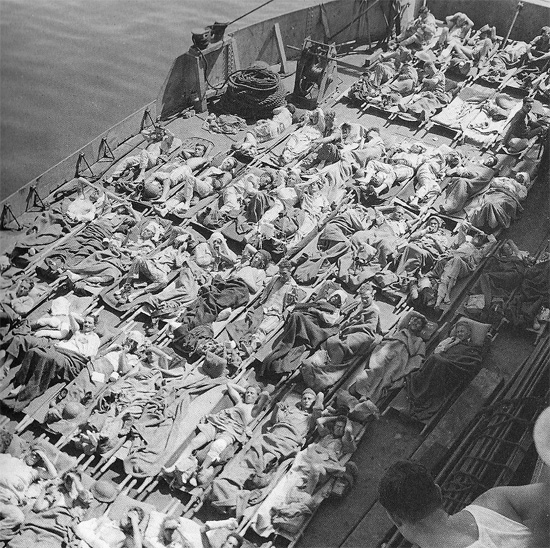
Large numbers of wounded are evacuated by landing craft to larger ships from Syracuse, Sicily to North Africa for further medical treatment.
Photo taken in July 1943.
Some burials took place at or near Hospitals, Posts, Bases, Railheads, and other installations in a Theater of Operations. Temporary cemeteries for deceased patients were primarily established in the vicinity of the units, and accessible to them. However, the availability of rail and motor facilities would certainly help, allowing transportation of bodies for burial from extended areas, in order to help keep the number of temporary cemeteries to the minimum. These bodies were to be exhumed later after cessation of hostilities, and evacuated to a proper established cemetery, and eventually disposed of at a suitable time (i.e. concentration in fixed American cemeteries overseas or return to the Zone of Interior –ed).
Overseas Movement & Operations:
North Africa
Operation “Torch” (Invasion of North Africa 8 Nov 42 –ed) field orders specified that tactical units would collect and bury their dead, and that unit commanders would check, inspect, and report in a proper way their graves registration activities. Plans for the “Western Task Force” included the assignment of the recently activated 46th and 47th Quartermaster Graves Registration Companies, but due to shipping restrictions both units remained behind in the Zone of Interior! The 47th QM GR Co landed in Oran, Algeria, 27 January 1943, and the 46th QM GR Co reached Casablanca, French Morocco 12 February 1943. This meant that as a rule unit Chaplains handled GRS operations with the assistance of NCOs and EM from either combat or medical organizations, meaning that only untrained detachments supplied by combat organizations were initially responsible for care of the dead!. AAR revealed that field commanders objected to employing combat troops for recovery and burial of their own dead, and recommended assigning specialized units for the job. Since there was no overall staff or agency to interpret operating procedures and regulations governing Graves Registration Service, a three-page pamphlet was therefore prepared and distributed by II Corps 20 December 1942 outlining procedures for the forthcoming Tunisian campaign. In short, the document requested strict reporting of burials and assigned such responsibility to a GRS Officer to be appointed in each combat unit (there were however no provisions regarding burial details, transportation and evacuation methods of the dead, and identification methods of the remains).
Once again, a certain improvisation took place and assignment of GRS Officers fell largely to unit Chaplains! The major problem was the lack of adequately and technically trained personnel and clearly described local organization and responsibility to effectively carry out operations. Due to a lack of trained personnel, the 47th was eventually subdivided into 20 different groups, several of which only consisted of 2 (two) Enlisted Men assigned to inactive cemeteries. An additional unit arrived late in summer of 1943; the 602d QM GR Co,which detailed small groups to different sites throughout Eastern Algeria and Tunisia.
Support of 1st Infantry Division – Algeria & Tunisia Campaigns
16 March 1943 > 7 July 1943
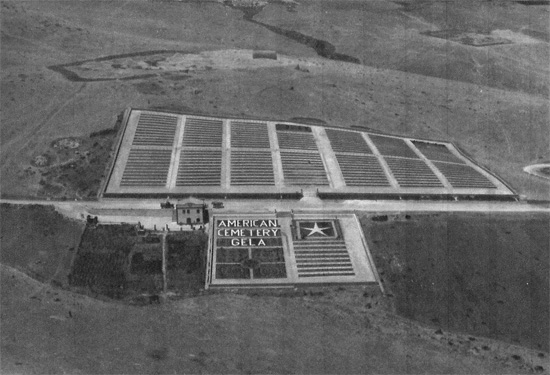
Aerial view of Gela American Cemetery, Sicily. The first American soldier was buried there on 21 July 1943 (photo taken by the Air Corps, ref # 60837 A.C.).
NATOUSA officially announced a Theater Graves Registration Service on 1 April 1943 under command of Colonel R. Howard, QMC. As GRS Officer, this person was to coordinate all field activities and maintain control of the Theater’s burial files. The new organization gradually settled struggling to enforce SOP for securing mortuary supplies, temporary burial sites, and a mortician’s services. Not only was personnel in short supply but a lack of adequate transportation hampered reaching some of the most advanced positions in the field. The reason to assign specific Graves Registration Service units was to spare combat troops the demoralizing experience of having to handle and bury their own dead (real and adequate planning for Graves Registration in fact would only begin early in 1943 with the launch of Operation “Husky”, the invasion of Sicily –ed). Wide improvisation would only end following the Sicilian and subsequent Italian campaigns. The 46th was still operating in Northern Tunisia in June when it received news that it would soon be relieved by the 47th QM GR Co in view of its participation in Operation “Husky”.
The Company’s Second Platoon was detached from its parent organization and remained in the Theater to tidy up GRS operations in North Africa, while the remainder of the unit moved on.
Sicily
For the inland operations in July 1943 a total of 6 QM GR Platoons were made available, with 1 extra Platoon in support of each Division. A Provisional Platoon was set up per sub-Task Force consisting of one Headquarters and three 7-man Sections (the latter all belonging to the 48th QM GR Co –ed).
In order to assume any contingencies with regard to potential losses, Major Albert J. Gricius, 45th Infantry Division GRS Officer distributed 3,000 temporary wooden markers, 4,000 white mattress covers, and 3,000 personal effects bags among the QM troops (the 46th supported both the 45th and 1st Infantry Divisions –ed).
As planners anticipated that beachheads of the different TFs were not expected to be consolidated quickly, they had to be self-sustaining for a period of time (estimate was 30 days –ed). This meant that each individual Task Force would receive a suitable quota of service troops. Based on this concept, separate Graves Registration Platoons were attached to the assault Divisions .
Unfortunately the situation did not develop as expected. The 46th QM GR Co (Headquarters + 2 Platoons) landed 14 July 1943 with 2 Officers and 56 EM, but brought no relief as they arrived without equipment and without vehicles. The men only recovered their equipment and organic vehicles four days later. This meant that the 1st Infantry Division had to organize the burials themselves between the period ranging from 10 to 20 July 1943. Gela Cemetery was officially opened 21 July 1943 by the 48th QM GR Co, assisted by Fourth Platoon, 46th QM GR Co.
Cemeteries Operated in Sicily
US Military Cemetery # 1 – Licata (176 American + 163 Enemy) opened 11 July 1943 – closed 11 August 1943
US Military Cemetery # 2 – Gela (1198 American + 835 Enemy) opened 21 July 1943 – closed 19 August 1944
US Military Cemetery # 3 – Caronia (658 American + 45 Italian Co-Belligerent + 825 Enemy) opened 15 August 1943 – closed 19 August 1944
US Military Cemetery # 4 – Palermo (376 American + 22 French) opened 24 July 1943 – closed ???
While active in Sicily, the 46th was not only carrying out its general GRS activities and operations, but Captain Merwin J. DeKorp, the organization’s CO was furthermore appointed Island Base Section Graves Registration Officer on 15 September 1943, which actually gave the unit dual duties during its stay on the island.
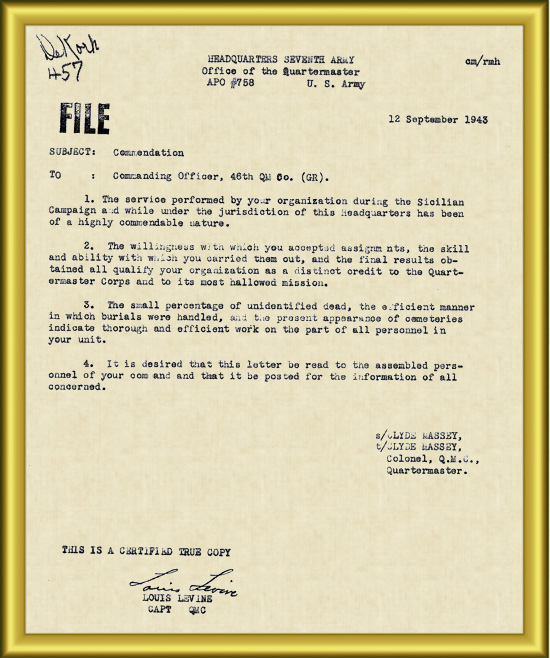
Commendation Letter from Headquarters Seventh United States Army, dated 12 September 1943, signed by Colonel Clyde Massey, Quartermaster, congratulating the organization for its outstanding performance during the Sicilian Campaign.
The services performed by the 46th Quartermaster Graves Registration Company during the Sicily campaign were of such a positive nature that the Seventh US Army Quartermaster wrote an official commendation dated 12 September 1943 addressed to the Commanding Officer thanking him for his skills and ability with which he carried out his mission and congratulating him and his men for the results obtained. A personal letter of commendation dated 13 December 1943 and signed by Lt. General George S. Patton, Jr. was later received by Captain M. J. DeKorp congratulating him for the superior and loyal manner in which he performed his GRS duties while stationed on Sicily.
Support of Seventh United States Army – Sicily Campaign
10 July 1943 > 5 June 1944
Italy
As a whole the Italian campaign represented the first real case in the development of Graves Registration Service. Starting from its operations in Salerno, Fifth United States Army used a divisional system of evacuating and burying its dead in Army cemeteries. Lt. Colonel Arthur L. Warren, Fifth United States Army Quartermaster controled all operations. Combat units evacuated their dead to divisional collecting points, situated very close to Quartermaster supply points where attached GRS Platoons assumed responsibility for identification of the remains, preparation of the mortuary records, and burial in the Army’s selected cemeteries. The greater part of the evacuation and burial work was accomplished by personnel of the 46th – 47th and 48th Quartermaster Graves Registration Companies (the 47th and 48th QM GR Cies, already seasoned by two campaigns were later rewarded with bronze “arrowheads” for their participation in the Salerno and Anzio assault landings).
For operations, the 46th worked under overall control of Fifth United States Army, which due to the vastness of the Italian mainland, assigned and attached Graves Registration Platoons to specific areas and units. General GRS activities were accomplished by a number of different organizations including the 46th QM GR Co – 47th QM GR Co – 48th QM GR Co as well as the 602d QM GR Co – 2611th QM GR Co – 2612th QM GR Co – 2613th QM GR Co and the 3044th QM GR Co (separate units were sent to Sardinia and Corsica –ed).
As Second Platoon, 46th Quartermaster Graves Registration Company, was earmarked to remain in the Theater for a while, a Fifth Platoon was activated to accompany Headquarters + 3 Platoons (during Operation “Dragoon”) in order to insure the integrity of the 46th QM GR Co’s operations. It opened the Follonica Cemetery on 29 June 1944.Second Platoon was only effectively inactivated 31 May 1944, by GO # 37, USAFIME, dated 22 May 1944 (United States Army Forces in the Middle East, CG, Major General Ralph Royce –ed).
By 1 August 1944, Headquarters and Fifth Platoon remained stationed in the vicinity of Pianura, Italy. Meanwhile First, Third, and Fourth Platoon after having received their individual assignments moved to the staging area. Usual routine camp duties followed from 1 to 18 August, interrupted by periodic inspections of individual clothing and equipment. Final orders were received 18 August, after which all equipment was loaded on the organization’s vehicles, and the latter with 7 drivers, were dispatched to the 36th Infantry Division staging area, pending movement by water. Meanwhile GR in Italy remained a VI Corps responsibility with support of 1 Platoon of the 47th plus 2 Platoons of the 48th QM GR handling the majority of all field operations.
On 20 August 1944, Headquarters and Fifth Platoon boarded LST # 286 in Naples harbor at 2000 hours, eventually sailing for Southern France, 22 August 1944 around 1600 hours.
Southern France – Central France
Reconstitution (following the Sicily Campaign) of Seventh United States Army in June 1944 included VI Corps Headquarters with 3 veteran Infantry Divisions, the 3d – 36th – 45th for the Southern France invasion.
Here follow some more data covering graves registration operations conducted by the 46th QM GR Co, after its landing in Southern France on 25 August 1944. They are based upon the monthly reports submitted to Seventh US Army Headquarters by the unit Commander, Captain M. J. DeKorp, QMC, between August 1944 and April 1945.

GRS personnel in the field check the personal effects of a dead soldier. Each article of personal effects removed from the body of a deceased member of the Armed Forces was to be listed on the Graves Registration Form No. 1 (Burial Report). All items were then placed in a personal effects pouch, which after being sealed was forwarded to the GRS Company Commander for a proper check; if proved correct, the pouch with contents was to be relocked and resealed, and then sent on to the higher echelon, prior to shipment to the Effects Quartermaster, Army Effects Bureau, Kansas City, Missouri, Zone of Interior.
August 1944
After debarkation at St. Tropez, France, on 25 August 1944, three Platoons of the 46th Graves Registration Company (minus one Platoon), each attached to a Division, first established a bivouac (between St. Tropez and Cogolin) and were then instructed to evacuate the dead through independent collecting points to a divisional cemetery (after the first weeks ashore, each Infantry Division established a suitable cemetery location –ed). On 26 August 1944, the organization’s CO, having landed, established immediate contact with the 3 Platoons already in operation, and inspected the temporary cemeteries thus far established. The very first (temporary) cemeteries opened were established at or near Cogolin (3d Inf Div); Valauris (45th Inf Div); and Draguignan (36th Inf Div).
In August 1944, while preparing for its transfer to southern France, a Fifth Platoon was added to the Company (to compensate for the loss of the Second platoon which had remained in North Africa –ed). This had become necessary because of the distribution and individual assignments of the different Platoons.
Following the arrival of the Company in Southern France, the Commanding Officer was made responsible for of all Seventh United States Army GRS activities. In view of the vast sector of operations involved and in order to centralize field work, Captain M. J. DeKorp was also put in command of all other units temporarily attached to the 46th.
The 46th was awarded a bronze “arrowhead” for their participation in the Sicily assault landing, and later received another one for their participation in the Southern France amphibious landing
Being judged unsuitable for further use, the entire Cogolin Cemetery was closed. Between 27 and 31 August, 139 Americans, 14 Allied, and 43 enemy dead were disinterred and reburied in the Draguignan American Military Cemetery.
On 31 August 1944, Headquarters and Fifth Platoon moved to Montélimar for the purpose of establishing a cemetery in the vicinity of the town. Totally different from operations in the Mediterranean Theater, the veterans of the 46th experienced the difficulty of evacuating their dead from a moving front that often outdistanced its cemeteries.

Copy of Report of Burial (Form 1 GRS) describing burial of an unknown American (designated X-43) at St. Juan American Cemetery, France, dated 20 September 1944, and signed by 2d Lieutenant Joseph Reek, QMC, 3d Platoon, 46th Quartermaster Graves Registration Company.
September 1944
By late afternoon of 1 September the selected site near Montélimar had been staked off, some graves dug, and 79 enemy bodies brought in from the wreckage of a destroyed German convoy. Arrangements were concluded for the procurement of 150 civilian laborers employed in the digging of graves. By 14 September 1944, 102 American and 290 enemy dead had been interred.
During the period 1 to 9 September 1944, Third and Fourth Platoon completed operations at the Draguignan Cemetery (operation later taken over by the 48th Quartermaster Graves Registration Company –ed). Meanwhile, First Platoon was performing a similar function at the cemetery established near Aix-en-Provence. By 10 September, First and Fourth Platoon operated a cemetery at Besançon (employing an additional 150-man civilian labor force), while Third Platoon set up at St. Juan (with help from enemy PWs and civilians). Headquarters and Fifth Platoon moved to Besançon on 18 September 1944 in anticipation of assuming control of that cemetery. On 19 September Headquarters and Fifth Platoon moved on to St. Juan, while Fourth Platoon remained at Besançon, and First Platoon traveled to Raddon to set up a collecting point. Several more collecting points and one shuttle point were established in order to regroup both American and enemy dead prior to burial.
On 27 September 1944, VI Corps established a centrally-located collecting point. Additional support and assistance would be made available by a Platoon of the 549th Quartermaster Laundry Company, and by the 3426th Quartermaster Truck Company. On 29 September, First, Third, and Fourth Platoons reverted to the control of the parent organization and were relieved from attachment to the 3d, 45th, and 36th Infantry Divisions.
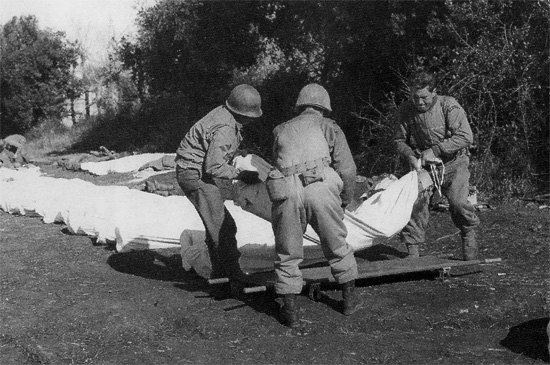
GRS personnel preparing bodies of deceased soldiers for proper burial. Please note the general use of white cotton mattress covers, Medical Department Item No. 71620 as body bags.
In view of its activities the Company was often required to request assistance from some of the major sections pertaining to Seventh US Army Headquarters. Based upon its authorized T/O & E strength, GRS Companies and/or Platoons did not have enough personnel or vehicles to recover and evacuate dead personnel. Therefore, they not only had to rely on assistance from the higher Corps or Army authority, but also had to hire and use local civilian and/or enemy PW labor to supplement their own personnel.
| Seventh United States Army – Medical Section Officers (+ 19 Enlisted Men) | |
| Colonel Frank B. Berry | Colonel Robert J. Goldson |
| Colonel Webb B. Gurley | Colonel Norman E. Peatfield |
| Colonel Joseph Rich | Colonel Albert H. Robinson |
| Colonel Myron P. Rudolph | Colonel Daniel S. Stevenson |
| Lt. Colonel Stewart F. Alexander | Lt. Colonel James E. Flinn |
| Lt. Colonel James E. Flinn | Lt. Colonel Charles Raulerson |
| Major Edith F. Frew | Major Henry C. Goss |
| Major Alfred O. Ludwig | Captain Frank L. Dunsmoor |
| Captain Harry M. Krasnoff | Captain Erskine M. Livingstone |
| 1st Lieutenant Raymond J. Hoesch | 1st Lieutenant Harry W. Sorenson |
| Warrant Officer Junior Grade Glen F. Morgan | |
| Seventh United States Army – Chaplain Section Officers | |
| Colonel Clarence S. Donnelly | |
| Captain Thomas J. Manley | |
| Seventh United States Army – Quartermaster Section Officers (+ 41 Enlisted Men) | |
| Colonel Clyde Massey | Colonel John L. Dicks |
| Colonel James F. Tweedy | Lt. Colonel Gordon C. Gill |
| Major Samuel E. Graham | Major William D. Pratt |
| Major Ronald N. Throop | Major Joseph N. Tucker |
| Captain James E. Bowler | Captain Edward F. Braithwaite |
| Captain George H. Garepy | Captain Frank T. Heinemann |
| Captain Ernest S. Johnson | Captain Henry R. McKee |
| Captain Richard L. Nispel | Captain Simon E. Stern |
| Captain Simon E. Stern | Captain Simon E. Stern |
| 1st Lieutenant Henry A. Miller | 1st Lieutenant Joseph P. Murphy |
| Chief Warrant Officer Adrian N. Winegarden | Warrant Officer Ross A. Jamieson |
| Warrant Officer Junior Grade Anthony Z. Cromwell | |
(above lists are based on Seventh US Army Reports of Operations 1944-1945, France and Germany, published in May 1946 –ed).
By the end of September 1944 a total of 490 American and 365 enemy dead had been interred in the St. Juan Cemetery, and 4 collecting points were in operation.

Casualties temporarily evacuated for treatment aboard US vessels off the coast of Southern France, 16 August 1944.
October 1944
Starting 1 October 1944, the unit was located at St. Juan, France, where it operated the cemetery and 4 collecting points. From 1 to 5 October, 178 American and 115 enemy bodies were recovered and interred in the cemetery, bringing the total number of burials at St. Juan to 805 and 553 respectively.
On 5 October 1944, Headquarters, 46th Quartermaster Graves Registration Company moved to Epinal, France for the purpose of establishing an Army Cemetery in its vicinity. Seventh US Army set up an official cemetery at Epinal, Vosges, France. For organizational purposes, it retained the distribution of Platoon attachments to individual Divisions. As more and more divisions joined VI and XV Corps, the system of attaching a Graves Registration Platoon to each Division became uniform. While sufficient personnel were left behind at St. Juan to facilitate disinterment of the Besançon Cemetery and reburial in the St. Juan Cemetery, all current collecting points and the Luxeuil shuttle point were closed and personnel informed to transport all bodies in the future to the newly-established American Cemetery at Epinal. Collecting points needed to be reshuffled to meet the ever changing tactical situation and this inevitably brought along breaking some of the Platoons into small detachments of 5 to 11 men to operate the many Division CPs.
Commencing on or about 9 October 1944, the 3041st Quartermaster Graves Registration Company (attached to XV Corps, and newly assigned to Seventh US Army 29 September 1944 –ed) began evacuating remains from the Lunéville sector to Epinal.
By 26 October the Besançon Cemetery had been completely disinterred and closed. By the end of October 1944 a total of 1301 Americans and 557 enemy dead had been buried in the Epinal Cemetery.
November 1944
On 1 November 1944, unit Headquarters was still at Epinal, France, operating the cemetery. The number of burials in the cemetery as of 2400 hours, 1 November, totaled 1351 Americans and 572 enemy. The organization employed 200 German PWs for digging graves. On 2 November, one of the unit’s ¾-ton Weapon Carriers was destroyed by a landmine in the vicinity of Bruyères, and the assistant driver lightly wounded.
Frequent changes in the tactical situation resulted in transfers of collecting point locations. As a result of the quick changes, the respective Platoons often had to move their collecting points to new sites. On 22 November, the Platoon operating at St. Juan was relieved by members of Second Platoon, 48th Quartermaster Graves Registration Company and returned to Epinal where it joined its parent unit. While the Epinal Cemetery was easily accessible to VI Corps personnel, it was not to XV Corps operating in the north. The steep mountain roads and difficult terrain through the Vosges region forced the 46th QM GR Co to open a new Military Cemetery at Hochfelden, approximately 15 miles northwest of Strasbourg, which was in effect a XV Corps site. On 24 November and for a number of days thereafter, Captain Merwin J. DeKorp, QMC, O-406311, made reconnaissance trips in the forward areas in search of a suitable new cemetery site. Following its selection, 1 Officer and 18 Enlisted Men left for the vicinity of Hochfelden, France, on 28 November, to start working on the layout of the new cemetery.
Throughout operations the important theme was to properly identify every American soldier deceased brought into the cemetery. Laundry marks, shoe size, fingerprints, physical characteristics, precise location of death with regard to units operating in the area at the time, were but several of the numerous clues which were used to advantage in a determined and successful effort to identify those fallen in battle. By the end of November, 3159 Americans and 1499 enemy had been interred by the Company in the American Cemetery at Epinal. By then every American soldier had been identified by name, except one, of which fingerprints had been taken.
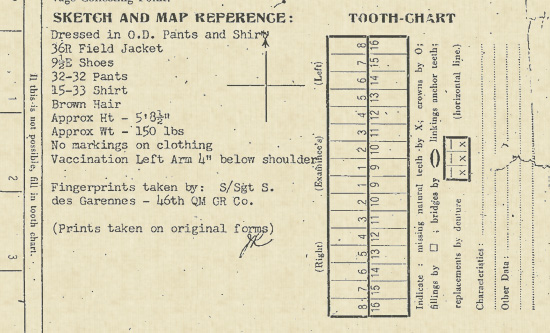
Partial view of Report of Burial (Form 1 GRS) indicating map reference, fingerprints, and condition of unknown American human remains as found on the battlefield in France (subject part of document filled out and signed by S/Sgt S. des Garennes, 3d Pltn, 46th QM GR Co., and dated 20 September 1944).
December 1944
On 1 December 1944, 46th QM GR Co Headquarters was still located at Epinal, France. Platoon detachments were maintaining collecting points and evacuating recovered bodies from Ste. Marie, Mutzig, and Bouxwiller, France to the cemetery. The total number of burials at 2400 hours, 1 December, was 3236 Americans and 1555 enemy.
With the steady retreat of the German forces the distance of evacuation between collecting points and the cemetery began to grow and a new cemetery was therefore chosen in a more forward area. On 3 December 1944, unit Headquarters entrucked to Hochfelden in anticipation of setting up a new cemetery. Commencing 4 December, all bodies were now to be evacuated to the new site. While establishing a new cemetery, sufficient men remained at Epinal to continue operating that cemetery. First burials were made in Hochfelden the same day, and included 36 American and 29 enemy bodies. Collecting points moved frequently, following the advancing troops, and because of the tactical situation and the many difficulties encountered, some men of the 48th Quartermaster Graves Registration Company were temporarily attached to the organization.
From 4 to 15 December 1944 a total of 729 American, 11 Allied, and 347 enemy dead were interred in Hochfelden. At the same timer Epinal Cemetery burials numbered 3609 Americans and 1703 enemy. Later, because of the limited road net and the further advance of the Allied armies to the east, instructions were received to select another cemetery which was opened at Niederbronn, France on 18 December 1944. Several other sites had been considered but were rejected because of the high water table prevailing. In view of the new setup at Niederbronn, Headquarters Detachment together with Second Platoon, 48th Quartermaster Graves Registration Company moved from Hochfelden to the new cemetery on 20 December. All clerks pertaining to the 46th, as well as 6 clerks from the 3041st Quartermaster Graves Registration Company were eventually transferred from Epinal to Niederbronn Cemetery.
As of 31 December 1944 burials continued withactivities rendered exceptionally difficult in view of the cold weather. Bodies requiring fingerprints were warmed near a fireplace so that the task might be accomplished properly. No less difficult was the job of searching these bodies for personal effects, many a corpse having been frozen in a crouching and other peculiar positions. The frozen terrain inhibited digging of graves with pick and shovel and increased labor and the use of pneumatic drills were several of the devices and means employed in overcoming this difficulty.
| 46th Quartermaster Graves Registration Company APO # 758 U.S. ARMY |
||
| 15 December 1944 | ||
| SUBJECT: | Daily Journal | |
| TO : | Army Quartermaster Seventh U.S. Army APO 758 (thru channels) |
|
| 1. The following journal is submitted in accordance with memorandum, Headquarters, Seventh U.S. Army, dated 1 August 1944:15 Nov 44 – Unit HQ located at Epinal, France, operating an Army Cemetery in the vicinity thereof. Organization’s collecting points are located at Rambervillers, Docelles and Brouvelieures. 45 American and 3 enemy evacuated to the cemetery; 48 Americans and 3 enemy buried. Prisoners of war employed in the digging of graves. A total of 2060 Americans and 923 enemy deceased have been interred in the U.S. Military Cemetery at Epinal as of 2400 hours this date. 16 Nov 44 – 78 Americans and 24 enemy evacuated to cemetery; 64 Americans and 23 enemy buried. Third Platoon established an additional point at Baccarat; Fourth Platoon established an additional collecting point at Laveline-devant-Bruyères. 17 Nov 44 – 64 Americans and 26 enemy evacuated to the cemetery; 69 Americans and 25 enemy buried. Organization lost one ¾-ton WC through mine explosion in the vicinity of Bruyères. The assistant driver was lightly wounded. The Third Platoon collecting points at Baccarat and Rambervillers were turned over to members of the 3041st QM GR Co. for operation. 18 Nov 44 – 109 Americans and 53 enemy evacuated to the cemetery; 82 Americans and 50 enemy buried. Fourth Platoon closed point at Docelles; First Platoon moved collecting points from Brouvelieures to Jeanménil. 19 Nov 44 – 73 Americans and 46 enemy evacuated to the cemetery; 94 Americans and 42 enemy buried. 20 Nov 44 – 133 Americans and 46 enemy evacuated to the cemetery; 102 Americans and 31 enemy buried. 21 Nov 44 – 59 Americans and 26 enemy evacuated to the cemetery; 99 Americans and 50 enemy buried. Fourth Platoon moved collecting point from Laveline-devant-Bruyères to Corcieux. 22 Nov 44 – 97 Americans and 36 enemy evacuated to cemetery; 85 Americans and 24 enemy buried. Personnel of this organization were relieved of duties at St. Juan Cemetery by members of Second Platoon, 48th QM GR Co. and returned to duty with parent unit at Epinal, France. 23 Nov 44 – 59 Americans and 25 enemy evacuated to cemetery; 52 Americans and 31 enemy buried. First Platoon moved collecting point from Jeanménil to Clairefontaine. 24 Nov 44 – 71 Americans and 35 enemy evacuated to cemetery; 90 Americans and 37 enemy buried. 25 Nov 44 – 53 Americans and 28 enemy evacuated to cemetery; 43 Americans and 33 enemy buried. Commanding Officer, this organization together with Graves Registration Service Officer, Seventh U.S. Army reconnoitered in forward areas in search of suitable site for a new Army Cemetery. 26 Nov 44 – 58 Americans and 32 enemy evacuated to cemetery; 68 Americans and 32 enemy buried. Further reconnaissance made in search of new cemetery site. 27 Nov 44 – 89 Americans and 68 enemy evacuated to cemetery; 74 Americans and 16 enemy buried. First Platoon moved collecting point to Saales. 28 Nov 44 – 61 Americans and 60 enemy evacuated to cemetery; 74 Americans and 95 enemy buried. 1 Officer and 18 Enlisted Men, this organization, left for vicinity of Hochfelden, France, to lay out new cemetery. Collecting points in operation at Ste. Marie, Mutzig, and Duntzenheim. 29 Nov 44 – 53 Americans and 49 enemy evacuated to cemetery; 53 Americans and 50 enemy buried. 30 Nov 44 – 70 Americans and 44 enemy evacuated to cemetery; 50 Americans and 37 enemy buried. Third Platoon moved point to Bouxwiller from Duntzenheim. By the end of the month 3159 Americans and 1499 enemy had been interred in the U.S. Military Cemetery at Epinal, France. |
||
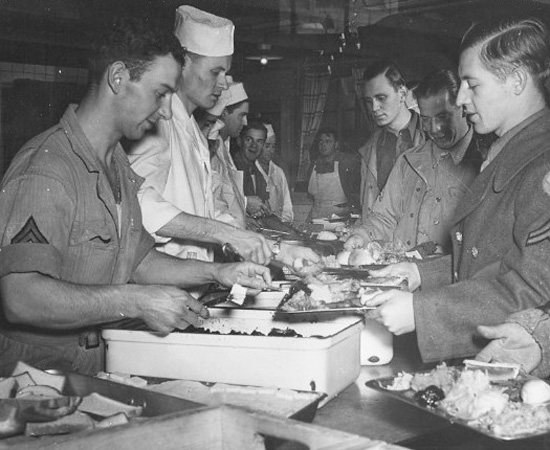
23 November 1944, GIs enjoy Thanksgiving Dinner somewhere in a barn, a requisitioned, or an abandoned building. It was always a treat to obtain some real hot chow with all the trimmings, and many a soldier ate until he got sick … unfortunately many others had to do with cold food outside …
| 1 Dec 44 – 77 Americans and 54 enemy evacuated to cemetery; 104 Americans and 56 enemy buried. 2 Dec 44 – 90 Americans and 29 enemy evacuated to cemetery; 68 Americans and 42 enemy buried. 3 Dec 44 – 88 Americans and 28 enemy evacuated to cemetery; 77 Americans and 28 enemy buried. Headquarters Detachment moved to Hochfelden, France, in anticipation of operation of new cemetery located in vicinity thereof. Personnel at collecting points informed to evacuate bodies to Hochfelden Cemetery commencing 4 December 1944. Fourth Platoon collecting point supporting 36th Infantry Division informed to continue evacuations to Epinal Cemetery in view of proximity of that particular point to Epinal. Approximately 200 PWs employed in the digging of graves at Hochfelden.4 Dec 44 – 69 Americans and 17 enemy evacuated to Epinal Cemetery; 36 Americans and 29 enemy evacuated to Hochfelden. 44 Americans and 23 enemy buried at Epinal; 36 Americans and 29 enemy buried at Hochfelden. Second Platoon, 48th QM GR Co. arrived at Hochfelden, France, to assist in cemetery operations. 5 Dec 44 – 16 Americans and 9 enemy evacuated to Epinal; 44 Americans and 35 enemy evacuated to Hochfelden Cemetery. 52 Americans and 10 enemy buried in Epinal Cemetery; 44 Americans and 13 enemy buried at Hochfelden. Fourth Platoon collecting point moved from Ste. Marie to Val-de-Ville. 6 Dec 44 – 19 Americans and 9 enemy evacuated to Epinal; 67 Americans and 18 enemy evacuated to Hochfelden. 42 Americans and 9 enemy buried at Epinal; 53 Americans and 17 enemy buried at Hochfelden. 7 Dec 44 -16 Americans and 22 enemy evacuated to Epinal; 61 Americans and 22 enemy evacuated to Hochfelden. 7 Americans and 21 enemy buried at Epinal Cemetery; 71 Americans and 23 enemy buried at Hochfelden. 8 Dec 44 – 20 Americans and 8 enemy evacuated to Epinal; 67 Americans and 36 enemy evacuated to Hochfelden. 24 Americans and 10 enemy dead buried at Epinal; 65 Americans and 35 enemy buried at Hochfelden. 9 Dec 44 – 5 Americans and 2 enemy evacuated to Epinal; 13 Americans and 4 enemy evacuated to Hochfelden. 12 Americans and 2 enemy buried at Epinal; 13 Americans and 4 enemy buried at Hochfelden. 10 Dec 44 – 12 Americans and 1 enemy evacuated to Epinal; 68 Americans and 43 enemy evacuated to Hochfelden. 8 Americans and 1 enemy buried at Epinal; 56 Americans and 39 enemy buried at Hochfelden. Fourth Platoon moved from Val-de-Ville to Ribeauville and Kintzheim, and is now bringing bodies to the Hochfelden Cemetery. First Platoon moved collecting point from Mutzig to Lingolsheim, France. 11 Dec 44 – 3 Americans and 2 enemy evacuated to Epinal Cemetery; 96 Americans and 28 enemy evacuated to Hochfelden Cemetery. 6 Americans and 2 enemy buried at Epinal; 79 Americans and 29 enemy buried at Hochfelden. In addition, 6 Allied were brought into Hochfelden Cemetery. 12 Dec 44 – 107 Americans, 6 Allied and 39 enemy evacuated to Hochfelden Cemetery. 133 Americans, 6 Allied and 41 enemy buried at Hochfelden. Fourth Platoon collecting point at Kintzheim closed and personnel withdrawn to Ribeauville. Third Platoon moved point from Bouxwiller to Muhlhausen. 13 Dec 44 – 5 Americans and 1 enemy evacuated to Epinal Cemetery. 73 Americans and 34 enemy evacuated to Hochfelden Cemetery. 6 Americans and no enemy buried at Epinal; 76 Americans and 35 enemy buried at Hochfelden. 14 Dec 44 – 103 Americans and 60 enemy evacuated to Hochfelden Cemetery; 103 Americans, 5 Allied, and 60 enemy dead buried. Third Platoon moved collecting point from Muhlhausen to Gumbrechtshoffen-Oberonn.On several occasions during the month of December 1944, it has been necessary for the 46th to return, or hold before burial, bodies which had been brought in from other Graves Registration Units and separate organizations, because of the lack of proper or complete information pertaining to the identity of the deceased. In every case, as a result of this close supervision of GRS operations, complete identities were established which otherwise would have been lost or jeopardized. |
||
| M. J. DeKorp, Captain, QMC, Commanding |
||
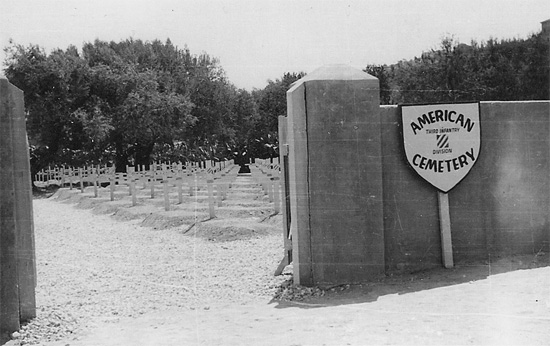
General view of entrance to Epinal Cemetery, France, January 1945.
Note:
The organization of the GRS in each Field Army of the United States Forces in the European Theater was essentially based on reworked and amended documents closely adhering to the general principles and procedures set forth in “Fifth United States Army Circular # 29, Battlefield Burials and Graves Registration by Troops”, dated 14 July 1943, followed by “Technical Bulletin # 46, Services of Supply, NATOUSA”, dated 1 August 1943; ultimately leading to “ETO-Standard Operating Procedure # 26, Army Burials, Graves Registration and Disposition of Effects”, dated 9 June 1944, which were made available to the assault troops for D-Day and which specified that:
Recovery, evacuation, and initial identification of the dead was a responsibility of Command within their zones of action.
For the rest, standard operating procedures intended to govern the participation of Quartermaster Graves Registration personnel in the operation of collecting points, and their other duties relating to positive identification of bodies, collection of personal effects, supervision of burials, registration of graves, and completion of burial reports, were in line with the established operational doctrine.
Authorized strength was based on T/O & E 10-298 dated 26 September 1944, which comprised 5 Officers and 260 Enlisted Men, 27 motor vehicles and 23 trailers. The initial organization authorized as per TO/ & E 10-297 dated 6 November 1943 only consisted of 6 Officers and 124 EM, 18 vehicles and 1 trailer (std. organization: 1 Company Headquarters and 4 Platoons; major tasks: identification and burial of dead, collection and disposition of personal effects, location and registration of battlefield graves and cemeteries -ed).
Personnel Roster: (incomplete)
Captain James Copeland
Captain Merwin J. DeKorp
First Lieutenant James E. Hawkins
First Lieutenant Brendon T. José
First Lieutenant Herbert G. Neal
First Lieutenant R. T. Schreiten
First Lieutenant Charles S. Troia, Sr.
First Lieutenant Vandermoor Van Utt
Second Lieutenant Joseph Reek
| Technical Sergeant William Jacobson | Technician 5th Grade Joseph J. Adriani |
| Staff Sergeant George Diestelmeyer | Technician 5th Grade C. Boesch |
| Staff Sergeant S. des Garennes | Technician 5th Grade Samuel I. David |
| Staff Sergeant Morris Wilson | Technician 5th Grade A. Gourley |
| Staff Sergeant Robert V. Fielding | Technician 5th Grade David Green, Jr. |
| Sergeant David G. Chapman | Technician 5th Grade Jan Niziolek |
| Sergeant Allen Gourley | Technician 5th Grade Terry |
| Sergeant Norman D. Hastings | Technician 5th Grade Solon C. Wilkes |
| Sergeant John T. Herook | Private First Class Robert Blackburn |
| Sergeant F. Loomis | Private First Class Clifford L. Bowman |
| Sergeant Wallace B. Mossefin | Private First Class Urban J. Boyer |
| Sergeant Berlin G. Myers | Private First Class E. Carr |
| Sergeant William T. Quinn | Private First Class Allen M. Davis |
| Sergeant J. Richardville | Private First Class Alex Evanoff |
| Sergeant W. Taylor | Private First Class Maynard E. Huenefeld |
| Sergeant Ivan S. Thurston | Private First Class Salvatore Maita |
| Sergeant Thomas Vlajkov | Private First Class Naylor |
| Sergeant Duane O. Woodcock | Private First Class Jack C. Neely |
| Sergeant Stanley Zwillinger | Private First Class Leonidas C. Roddey |
| Corporal Edward Zakerzewski | Private First Class Philip Skoog |
Private Stanley Alicki
Private Roy T. Boshears
Private Robert Ganz
Private Everett G. Green
Private Charles Rajski
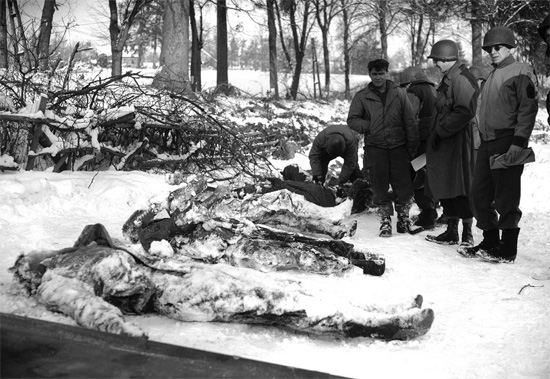
Graves Registration and Medical Corps personnel check recovered frozen American and enemy dead.
January 1945
On 1 January 1945 the organization’s Headquarters was still at Epinal, France. In addition to this operation, the Company’s Commanding Officer assisted by 20 EM remained at Niederbronn, France, to complete operation of that cemetery. Following severe enemy pressure and short attacks it was overrun by the enemy early January, and although quickly recovered, it never reopened (most of the men had been withdrawn to Epinal –ed), officially closing on 2 January 1945. The total number of burials was only 421 Americans and 235 enemy. Total burials in Epinal Cemetery had meanwhile reached 3829 Americans and 1868 Germans.
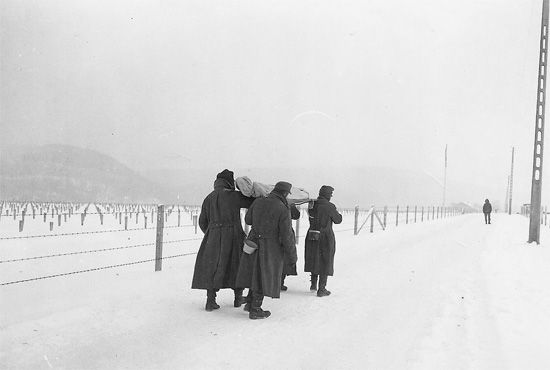
German PWs carry an American soldier to his last resting place in Epinal American Cemetery, France. Photo taken 12 January 1945.
Constant fluctuations in battle brought about equally frequent changes in the location of the various collecting points. During January operations were rendered unusually difficult as a result of the winter conditions. Ground frost line averaged 2 ½ feet, practically prohibiting digging. In order to overcome this additional difficulty the Company worked three shifts, operating 24 hours a day, employing every tool available to its fullest advantage. With the gradual rise in temperature toward the end of the month, the snow and ice thawed out. The graves quickly filled with water and required the use of pumps to clear them.
Following the increase in military activities the necessity of expansion of the Epinal Cemetery became apparent. Consequently additional plots were laid out, bringing the total new capacity of the cemetery to:
8832 Americans
144 Executed General Prisoners Plot
144 Allied
4404 Enemy
On 31 January 1945 the aggregate number of burials at Epinal Cemetery numbered 5291 Americans, 6 Allied, and 2702 Germans (among the Americans were 9 unknown, of these 4 had been fingerprinted, 3 had come out of a destroyed tank, and 1 was a member of a crashed plane crew).
Because of the expansion program, Second and Fourth Platoons, 48th Quartermaster Graves Registration Company plus personnel of the 3041st Quartermaster Graves Registration Company assisted the organization in the overall maintenance of the American Cemetery at Epinal, France.
February 1945
On 1 February the organization’s Headquarters was still at Epinal, France, continuing operations of the American Military Cemetery established following orders from Seventh United States Army authorities. As of the same date, Detachments were operating collecting points at 5 different locations. The total number of burials had meanwhile reached 5341 Americans, 6 Allied, and 2753 Germans. By the time labor shortage and frozen terrain conditions no longer existed. Toward the middle of the month trips were begun to locate a new cemetery site in or around St. Avold, France. On 26 February, such a site having been selected, a detachment left Epinal in order to prepare the new cemetery location for operation.
Fluctuations in the movements of collecting points were far less numerous compared to previous months, and the trend was essentially toward the return of CP personnel to their parent unit. Between 4 and 27 February 1945 all personnel were withdrawn to Epinal Cemetery.
At the close of the month, 7151 American, 24 Allied, and 4407 enemy dead had been interred at Epinal, France. Of the total number of American dead, 8 were unknown, and during this period, 4, previously reported as unknown had successfully been identified. Epinal Cemetery continued its active role as the principal Army cemetery during January and February 1945.
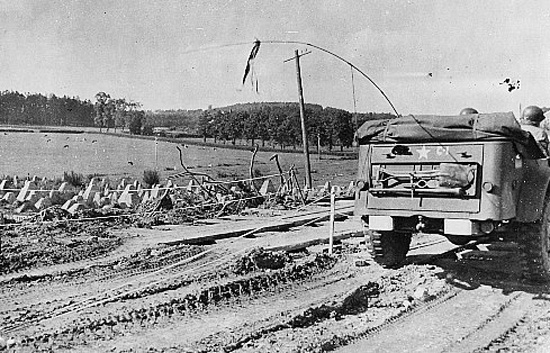
Winter 1945, reconnaisance along the Siegfried Line, in search of an appropriate site for setting up operations …
March 1945
On 1 March 1945, the 46th continued to maintain the American Cemetery at Epinal, France. Only 2 collecting points had been maintained. As a new cemetery site in the vicinity of St. Avold, France, had by this time been selected, a detachment departed Epinal for preparing the new location. The lack of necessary labor details, however, hampered progress and it wasn’t until 15 March 1945 that operations were officially started. Unit Headquarters had meanwhile moved to St. Avold 14 March (Epinal and Hochfelden Cemeteries continued in use until St. Avold, the largest Seventh United States Army Military Cemetery in France opened –ed).
The swift progress of Allied troops was reflected in the fluidity of the organization’s collecting points and by 25 March, St. Avold was far behind the lines, rendering evacuation of bodies difficult. New and additional collecting points had therefore to be established further onward.
On 16 March, the 4333d Quartermaster Service Company was attached to the 46th for operations, furnishing the necessary labor details for maintenance of the St. Avold Cemetery.
On 18 March 1945, personnel moved to Herbitzheim, thus establishing its first collecting point operated by the organization in Germany, an enemy country! It then went further with collecting points being gradually moved deeper into Germany. Successful operations during the month and in the past months were greatly facilitated by the attachment for operations of additional Graves Registration and Service QM personnel. The 3041st Quartermaster Graves Registration Company maintained collecting points in support of operations and assisted in cemetery work and the preparation of clerical forms; the 606th Quartermaster Graves Registration Company was assigned the duty of searching for and evacuating remains of deceased personnel from the Colmar and Haguenau sectors and of maintaining 2 collecting points. At the end of the month, they were relieved by the First Platoon, 610th Quartermaster Graves Registration Company who took over operation of these CPs. Second and Fourth Platoon, 48th Quartermaster Graves Registration Company were attached for operational purposes and also maintained a collecting point during March, and assisted in the preparation of paperwork and cemetery maintenance.
By 25 March the distance of evacuations from the collecting points to the St. Avold Cemetery ranged from 80 to 100 miles. A reconnaissance party therefore left in search of a new cemetery site west of Grünstadt, Germany. By 29 March 1945 it became however obvious that this site would have to be abandoned in favor of a more advanced location. Accordingly a new site was looked for and selected in the vicinity of Bensheim, Germany, east of the River Rhine. Personnel were immediately dispatched there to make the necessary preparations for operation of the cemetery.
As of 31 March 1945 a total of 1560 Americans, 14 Allies, and 1128 Germans had been interred in the St. Avold Cemetery, France. 6 Americans remained unidentified. During the month operations continued at Epinal Cemetery. Out of a total of 14 unknown dead in that cemetery, 11 had been fingerprinted for identification.

Map illustrating Seventh United States Army Supply Dumps, during October-December 1944.
Germany
April 1945
The unit’s Headquarters moved to Bensheim, Germany from St. Avold, France on 1 April 1945 in order to operate the new facility. The same day initial evacuations comprised 52 American and 6 enemy dead.
The rapid progress of the troops affected the location of the different collecting points which had to move frequently and before the end of the month, the Bensheim Cemetery was already far behind the lines, rendering evacuation of bodies difficult. By 25 April, the distance of evacuation averaged 200 miles. On 26 April, a detachment left for Ulm, Germany, for the purpose of selecting a new site, and a suitable one was chosen at Reutti, Germany the following day. Initial burials at the new location were begun on 30 April 1945.
At the time Seventh US Army elements were driving north of the Augsburg-Munich Autobahn towards the capital city of Bavaria. In the center of the XV Corps sector, troops belonging to the 42d and 45th Infantry Divisions moved forward despite enemy delaying actions. In front lay Dachau where the nazi regime had established one of its first and largest concentration camps. When US forces broke through the camp’s gates on Sunday afternoon, 29 April 1945, they discovered more horrors of war. The sight was unbelievable; freight cars filled with bodies, emaciated prisoners shot by their guards, rooms stacked with tangled human bodies, dying survivors everywhere … “it was unbelievable – freight cars full of piled cadavers no more than bones covered with skin, bloody heaps at the rail car doors where weakened and emaciated prisoners, trying to get out, had been machine gunned to death by the SS – barrack rooms stacked high with tangled human bodies adjoining the cremation furnaces – rooms with dying survivors, limp under filthy blankets, laying in human excreta, trying to salute our GIs with broomstick arms, only to fall back …”
(excerpts – The Seventh United States Army Report of Operations, France and Germany 1944-1945, Volume III, Chapter XXIX, The Myth of the National Redoubt, Printed in Germany, May 1946 –ed). It was reported that I Company, 222d Infantry Regiment, 42d Infantry Division, entered the camp at 1313 hours, and that the Second Battalion, 157th Infantry Regiment, 45th Infantry Division entered Dachau at 1445 hours and cleared it by 1705 hours. The majority of the former camp inmates (political prisoners, prisoners of war, and jews –ed) were treated on site at Dachau or in the vicinity thereof by a number of medical units. Some of the medical personnel involved belonged to the 120th Medical Battalion, the 59th Evacuation Hospital, the 66th Field Hospital, and the 116th and 127th Evacuation Hospitals. They too were informed about the atrocities committed by members of the German armed forces.
Operations in Germany were facilitated with the assistance of additional Quartermaster units. The 3041st Quartermaster Graves Registration Company as well as First Platoon, 610th Quartermaster Graves Registration Company maintained collecting points in support of operations and assisted with the clerical work. Second and Fourth Platoon, 48th Quartermaster Graves Registration Company remained attached for operational and clerical purposes and the 4460th Quartermaster Service Company was not only attached for recovering the dead bodies at the different collecting points but also furnished guard details for the PW labor employed.
At the end of April, a total of 2666 American, 53 Allied, 1 Co-Belligerent, and 1503 enemy dead had been buried in the American Military Cemetery at Bensheim, Germany.
May 1945
On 1 May 1945, the organization was located at Reutti, Germany where it operated and maintained the cemetery. 3 collecting points were set up in support of the 45th Infantry, the 3d and 14th Armored Divisions. During the final stage of the war in Europe, the collecting points were mostly static. Operations were facilitated by the attachment of additional QM Graves Registration and Service units, such as: Second & Fourth Platoon, 48th Quartermaster Graves Registration Company; First Platoon, 610th Quartermaster Graves Registration Company; 3041st Quartermaster Graves Registration Company and the 4460th Quartermaster Service Company. All personnel assisted in cemetery maintenance and collecting point operations.
By V-E Day approximately 117,000 American dead were buried in 54 temporary military cemeteries (ultimately, about 146,000 bodies would be recovered in the ETO alone –ed).
At the end of May 1945, a total of 420 American, 24 Allied, and 187 enemy bodies had been interred in the Reutti American Military Cemetery, Germany.
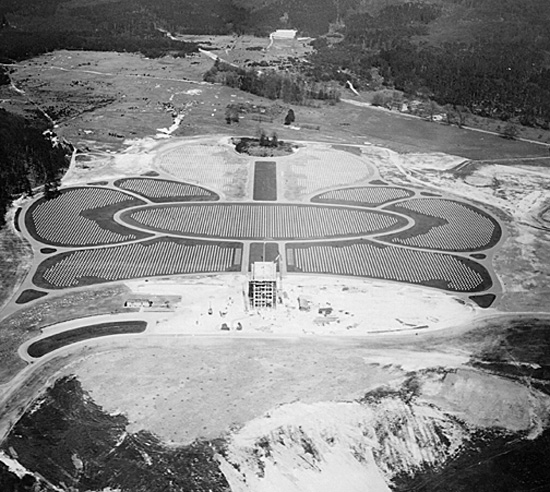
Aerial view of St. Avold American Cemetery, France. Photo taken March 1945.
June 1945
On 1 June 1945, the organization Headquarters was still at Reutti, Germany, maintaining the American Military Cemetery there. Three collecting points were in operation supporting the 45th Infantry, the 3d and 12th Armored, and the 101st Airborne Divisions.
With the war in Europe now over, more time was devoted to isolated burials, and disinterring crews were sent to various parts of southern Germany and Austria, recovering bodies of deceased Army Air Forces personnel and the more recent graves of military personnel given a hasty battlefield burial. With divisions moving into semi-permanent occupational territories, it was necessary to transfer the collecting points accordingly.
Captain M. J. DeKorp, QMC, CO, 46th QM GR Co, was relieved from assignment 6 June 1945 and temporarily replaced by 1st Lieutenant Vandermoor Van Utt, QMC,who became Acting Commander. On 8 June 1945, Captain DeKorp was appointed Executive Officer, 205th Quartermaster Battalion, and 1st Lieutenant Charles S. Troia, QMC assumed effective command of the 46th. On 9 june, the Reutti Cemetery was turned over to First Platoon, 610th Quartermaster Graves Registration Company, and the following day it arrived at Bensheim to assist the 48th Quartermaster Graves Registration Company with operations and maintenance.
In accordance with general policy and following the end of the hostilities the Redeployment system was set in motion with the arrival of reinforcements/replacements and the release of personnel following their individual ASR score.
With the loss of the current CO, 1st Lieutenant C. S. Troia, through the Redeployment and Readjustment system, 1st Lieutenant James E. Hawkins, QMC assumed command of the 46th. Reinforcements who were designated clerks were sent to Headquarters, 48th Quartermaster Graves Registration Company, to learn and assist in the preparation of the necessary QMC and AGD forms while medical personnel were dispatched to Bensheim Cemetery, Germany, to help with the processing of deceased personnel.
August 1945
During an official ceremony in August 1945, Captain Merwin J. DeKorp was awarded the “Legion of Merit” in Heidelberg, Germany (ref. Ltr ETOUSA, Auth, Para II, GO 125, dtd 17 Jun 45) for his outstanding service record; the reason for this award was because his unit had the highest percentage of identified dead soldiers in the European Theater and also for his exceptionally meritorious conduct in the performance of his GRS activities, while serving with Seventh United States Army (Seventh United States Army wasn’t the only successful group with regard to GRS operations. The percentage of unidentified bodies interred indicated the degree of efficiency in Graves Registration operations in the European Theater. As such, Third US Army’s wartime record was 0.58%; Fifth US Army’s most favorable figure was reached in Italy with 1.1%; and First US Army’s percentage reached 1.6% -ed).
Finale:
On 1 August 1945, the organization was located at Auerbach, Germany. Following new instructions, the 46th QM GR Co recalled all investigating teams to Company Headquarters per VO received from the First Quartermaster Group effective 25 August (which assumed GRS responsibilities within ADSEC, under command of Lt. Colonel Maurice L. Whitney –ed). The allotted area assigned the unit to be investigated was nearly completed upon being recalled.
On 6 September 1945, the 46th Quartermaster Graves Registration Company was relieved from assignment to Seventh United States Army and assigned to Theater Service Forces, European Theater (TSFET), per Assignment & Attachment Order # 110, Headquarters, Seventh US Army, dated 28 August 1945 (a US Theater Graves Registration Service, Theater Service Forces, European Theater had been created 2 August 1945, under command of Brigadier General James W. Younger, Director General –ed).
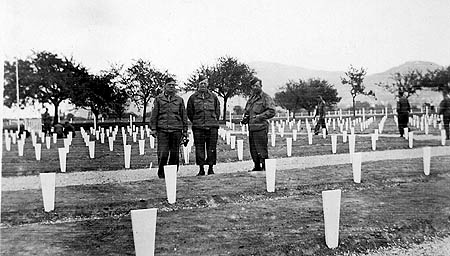
Partial view of Bensheim American Cemetery, Germany. Photo taken April-May 1945. Temporary wooden name pegs still adorn the individual graves.
Due to the reduction in personnel under the Redeployment & Readjustment system, it became necessary to operate with the minimum of personnel. The unit was in operation since 6 September 1945, using only its available personnel, disinterring Bensheim American Military Cemetery and transferring the remains of the deceased to the American Military Cemetety at St. Avold, France (the latter would become the largest Seventh US Army Cemetery in the ETO –ed).
At the end of the war, the plan was to select 10 permanent sites for establishing American Military Cemeteries, mostly associated or related to a nearby important battle or campaign.
Support of Seventh United States Army – Southern France Campaign
25 August 1944 > 1 April 1945 (relieved from assignment 6 Sep 45)
It must be noted that First, Seventh and Ninth US Armies used the same cemeteries for both American and enemy dead, be it segregated in plots. Only Third US Army buried Germans in separate cemeteries. American dead recovered were mostly fully clothed and some even still had their web and gear on. All usable government-issue equipment was removed, sorted, and ammunition and arms secured. Security was necessary as civilian laborers often tried to remove pieces of clothing they could put to good personal use. White cotton mattress covers served as body bags, effects bags were kept available, and proper wooden stakes were prepared for each individual grave.
Overseas Stations – 46th Quartermaster Graves Registration Company
Aleutians Islands – 1943
Algeria – 2 March 1943 > 10 May 1943
Tunisia – 11 May 1943 > 8 July 1943
Sicily – 10 July 1943 > 5 June 1944
Italy – 5 June 1944 > 22 August 1944
Southern France – 25 August 1944 > 1 April 1945
Germany – 1 April 1945 > ?? October 1945
US Military Cemeteries Operated and Maintained by the 46th Quartermaster Graves Registration Company
Draguignan, France
Aix-en-Provence, France
Besançon, France
St. Juan, France
Epinal, France
Hochfelden, France
Niederbronn, France
St. Avold, France
Bensheim, Germany
Reutti, Germany
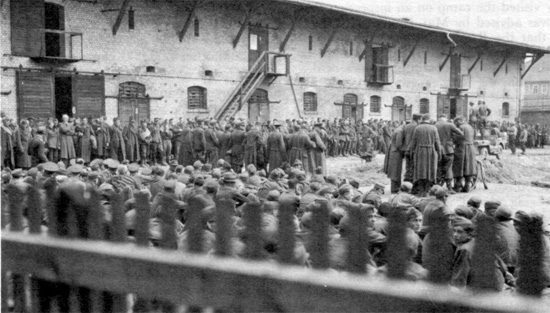
Picture illustrating one of the many improvised German Prisoner of War Enclosures in Germany, following the collapse and mass surrender of the German Armed Forces.
Campaign Awards – 46th Quartermaster Graves Registration Company
Rome-Arno Campaign
Rhineland Campaign
Central Europe Campaign
Unit Awards – 46th Quartermaster Graves Registration Company
Unit Commendation (Hq Seventh US Army, dated 12 Sep 43)
Unit Commendation (Hq Island Base Section, dated 5 Mar 44)
Unit Commendation (Hq Island Base Section, dated 29 May 44)
Meritorious Service Unit Plaque (Hq Seventh US Army, GO # 10, dated 16 Jan 45)
Unit Commendation (Hq Seventh US Army, dated 6 May 45)
Arrowhead Device (Hq Seventh US Army, GO # 70, dated 20 Aug 45, for Sicily)
Arrowhead Device (Hq Seventh US Army, GO # 70, dated 20 Aug 45, for Southern France)
Special Note:
Distinguished Unit Status:
Under the provisions of Circular, Quartermaster Hall of Fame and Distinguished Member/Unit of the Regiment Nominating Procedures, the 46th Quartermaster Graves Registration Company was nominated and subsequently inducted in 2003 as a “Distinguished Unit”.
“The 46th QM GR Co was assigned to the TF for the Liberation of the Aleutian Islands in 1943. Then as the war continued and moved on, the unit was part of the forces that served in the North Africa, Sicily, Italy, Southern France and Germany Campaigns. Bronze Arrowheads and Battle Stars were awarded to the organization and its personnel. The 46th left its mark and signature, the Company Commander, Officers, Noncommissioned Officers and the Enlisted Men made it one of the most outstanding Graves Registration Companies in the United States Army. The “unknown” burial rate of this unit was the lowest in any unit serving with the Army during WWII. A record that is almost impossible to comprehend. A point that must not be overlooked or missed is the position of the Commanding Officer, Captain M. J. DeKorp while assigned to the Seventh United States Army. From what can be gleaned from the unit journals and reports of Quartermaster Graves Registration Companies assigned to the Seventh US Army in the ETO, is that all these were attached to the 46th QM GR Co for operations. Who did what and where were Captain DeKorp’s responsibility: recovering the dead, opening cemeteries, operating cemeteries, closing cemeteries, opening and closing of collecting points, area search and recovery, and the utilization of assigned and attached personnel of these units.
The 46th was without a doubt the most outstanding QM GR unit and no other organization can match its being in the forefront of the carrying of the Quartermaster Banner. The Commander and the entire complement of Officers and Enlisted Men of the 46th Quartermaster Graves Registration Company were outstanding emissaries for the Quartermaster Corps. The organization upheld, on a continuous basis, the Honor and Traditions of the Quartermaster Corps in a superior manner in the Aleutian Islands, North Africa, Sicily, Italy and the European Theater of Operations.
In view of the above and for its display of superior and commendable service during World War Two, the 46th Quartermaster Graves Registration Company is highly recommended for induction into the Quartermaster Regiment as a Distinguished Unit.”
(excerpts – Letter to the Commanding General, The Quartermaster Center and School, Fort Lee, Virginia, dated 21 October 2002, signed by Lt. Colonel Charles D. Butte (USA Ret) a Veteran of the 603d QM GR Co –ed).
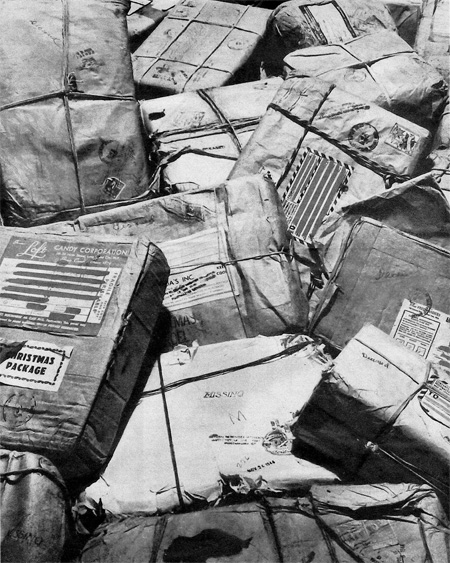
During 1944 when American war casualties in the E.T.O. were the highest, relics of destroyed lives turned up in many places. Not only personal effects but also United States Post Office packages, gifts, and other goodies were collected and returned to the Zone of Interior stamped missing – deceased – killed in action – return to sender – cannot be delivered … the cruel reality of war …
Special thanks must go to the DeKorp family members including Jane DeKorp Verderosa, Nancy DeKorp, and Roger DeKorp for sharing precious historic documents, data, and photographs, relating to the 46th QM GR Co and their Father, Major Merwin J. DeKorp (O-406311) who joined the unit 11 May 1942, and served as its Commanding Officer from 15 March 1943 to 6 June 1945. We are also grateful to Dutch Historian and Researcher Jan Bos for providing us with some extra information about the 46th. The MRC Staff are still looking for data relating to the unit’s early operation in the Aleutians, and a complete Personnel Roster.
